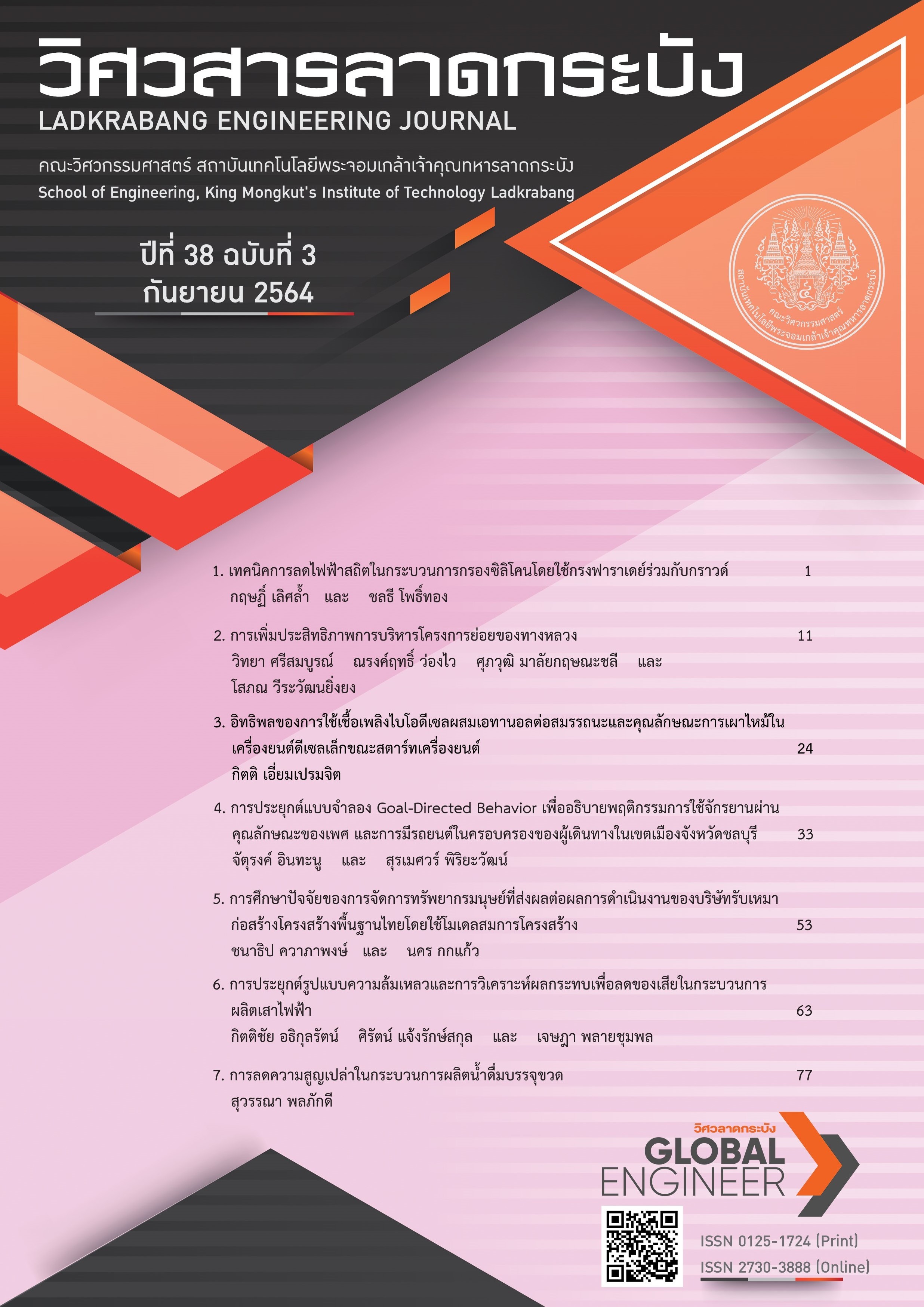Electro-Static Discharge Reduction in Silicone Filter Process using Faraday Cage with Ground Technique
Keywords:
Electro-static reduction, Faraday cage, Silicone filling processAbstract
This research aims to reduce electro-static discharge and increase safety for workers in the silicone filling process by using the Faraday cage technique. The research found that the electro-static and its discharge occurred rapidly and severely, which was caused by the friction of triboelectric series material, silicone, and nylon filter cloth, that was compressed by very high compression of 150-200 bars. This electro-static discharge was therefore dangerous for the workers. This research proposes design and construction of an equipment set to eliminate the problem. The experimental test scenarios were divided into 3 cases: without the Faraday cage, with the Faraday cage but without grounding and with Faraday cage with grounding. According to the research results, it was found that by installing the Faraday cage solely could reduce the amount of electro-static discharge by 51% but with also the additional grounding could reduce the amount of electro-static by 71 % when grounded, compared to one without the Faraday cage.
References
S. C. Shit and P. Shah, “A review on silicone rubber,” National Academy Science Letters, vol. 36, no. 4, pp. 355–365, 2013.
K. E. Polmanteer, “Silicone rubber, its development and technological progress,” Rubber chemistry and technology, vol. 61, no. 3, pp. 470–502, 1988, doi: 10.5254/1.3536197.
S. Srirod, and P. Damrongkulkamjorn, “Reduction of Electrostatic Hazards in Textile Finishing Plants,” Kasetsart Engineering Journal, vol. 22, no. 69, pp.1–12, 2009.
S. Pan and Z. Zhang, “Fundamental theories and basic principles of triboelectric effect: A review,” Friction, vol. 7, no. 1, pp. 2–17, 2019, doi: 10.1007/s40544-018-0217-7.
M. A. Kelly, G. E. Servais, and T. V. Pfaffenbach, “An investigation of human body electrostatic discharge,” in the 19th International Symposium for Testing & Failure Analysis, Los Angeles, CA, USA, Nov. 15–19, 1993, pp. 167–173.
A. Wattanahuttakum, S. Deeum, and B. Limpiyapun, “Effect of electrostatic on weighing accuracy,” Bulletin of Applied Sciences, vol. 8, no. 8, pp. 64–71,2019.
N. Jai-ngam. “Reduction of defects from electrostatic discharge in the head gimbal stack assembly line by applying the six sigma method,” M.S diss., Dept. Ind. Eng., Chulalongkorn University, Bangkok, Thailand, 1999.
S. Arunsawad, "Preparation of Graphene/Poly (Pyrrole-co- Formyl Pyrrole) Composites for Antistatic Polyurethane Coating,” M.S. diss., Dept. Petrochemistry and Polymer Sciences, Chulalongkorn University, Bangkok, Thailand, 2014.
P. Nuamcharoen, “ Physical properties of reduced graphene oxide/poly (butylene succinate) composites,” M.S. diss., Dept. Petrochemistry and Polymer Sciences, Chulalongkorn University, Bangkok, Thailand, 2015.
K. Sathansatit, S. Chousakul, W. P. Ouajai and S. Ouajai, “Mechanical, Thermal and Electrical Properties of LLDPE Filled with Polypyrrole and Carbon Black,” Journal of King Mongkut’s University of Technology North Bangkok, vol. 21, no. 2, pp. 349–356, 2011.
W. Srihata and S. Kaewpirom, “Anti-electrostatic Discharge Materials from Chitosan/poly (ethylene glycol) Blends,” The Journal of Industrial Technology, vol. 9, no. 2, pp. 1–10, 2013.
S. Damrongkittikul, D. Saenrak et al., CODE OF PRACTICE FOR DESIGN, INSTALLATION, INSPECTION AND TESTING OF GROUNDING SYSTEM. Council of Engineers, Bangkok, Thailand, 2011.
M. Chaoluang, P. Sanposh and W. Kanokbannakorn, “ANALYSIS OF GROUNDING SYSTEM FOR SAFETY IN GAS PRODUCTION AND GAS FILLING PLANT,” Srinakharinwirot University (Journal of Science and Technology), vol. 9, no. 18, pp. 136–149, 2017.
M. Pusayatanont and B. Sookananta, “External Lightning Protection Systems,” UBU Engineering Journal, vol. 6, no. 2, pp. 112–124, 2013.
S. J. Chapman, D. P. Hewett and L. N. Trefethen, “Mathematics of the Faraday cage,” Siam Review, vol. 57, no. 3, pp. 398–417, 2015.
N. A. Zakaria, R. Sudirman and M. N. Jamaluddin, “Electromagnetic Interference Effect from Power Line Noise in Electrocardiograph Signal using Faraday Cage,” in 2008 IEEE 2nd International on Power and Energy Conference, Johor Baharu, Malaysia, Dec. 1–3, 2008, pp. 666–671. doi: 10.1109/PECON.2008.4762559.
E. T. Whittaker, “Albert Einstein, 1879–1955,” Biographical Memoirs of Fellows of the Royal Society, vol. 1, pp. 37–67, 1955, doi: 10.1098/rsbm.1955.0005.
J. Lekuthai, B. Cherdhirunkorn and J. Panityotai, “Development of the Polarization-Electric Field Hysteresis Loop Measurement Set for Ferroelectric Materials,” Thai Science and Technology Journal (TSTJ), vol. 23, no. 3, pp. 466–474, 2015.
N. Thongchompoo, “A Study and Analysis of Lightning Effects on PV and Protection,” M.S diss., Dept. Electr. Eng., Rajamangala University of Technology Thanyaburi, Pathum Thani, Thailand.
P. Rojthanawanit, “Study on the electrostatic and electrokinetic characteristics of particles in an insulating oil,” M.S. diss. Chulalongkorn University, Bangkok, Thailand, 2019.
J. W. Boag, "The design of the electric field in a Van de Graaff generator," in Proceedings of the IEE-Part IV: Institution Monographs, vol.100, no. 5, pp. 63–82, 1953, doi: 10.1049/pi-4.1953.0010.
M. Kim, Y. Cheong and J. Song, "The meanings of physics equations and physics education," Journal of the Korean Physical Society, vol. 73, no. 2, pp. 145–151, 2018, doi: 10.3938/jkps.73.145.
Downloads
Published
How to Cite
Issue
Section
License
Copyright (c) 2021 Faculty of Engineering, King Mongkut’s Institute of Technology Ladkrabang

This work is licensed under a Creative Commons Attribution-NonCommercial-NoDerivatives 4.0 International License.
The published articles are copyrighted by the School of Engineering, King Mongkut's Institute of Technology Ladkrabang.
The statements contained in each article in this academic journal are the personal opinions of each author and are not related to King Mongkut's Institute of Technology Ladkrabang and other faculty members in the institute.
Responsibility for all elements of each article belongs to each author; If there are any mistakes, each author is solely responsible for his own articles.






